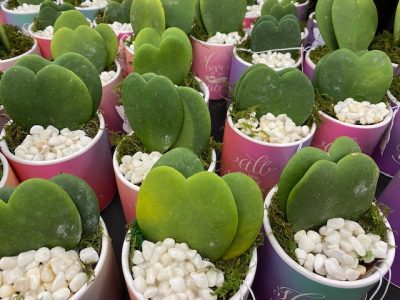By Dr. Matthew Lisy, UConn Adjunct Faculty

Once again, the winter holiday season is upon us! I am sure I have said this before, but I never cease to be amazed at the seemingly endless varieties of holiday plants available. This year, I planned on not buying any holiday plants, but one trip to two local greenhouses changed my mind immediately. If one plant could exemplify the season, it would be the Poinsettia. Although red and white Poinsettias have been the standard for many years, there are a lot of really neat colors available if you look hard enough. One of my all-time favorites is orange. I used to grow this variety when it first came out, and could never stock enough of them. In the old days, you needed to set it next to a red one to tell the difference, but fast forward many years, and the orange is now much more intense and can stand alone in all its glory.
If I had to pick just one favorite Poinsettia, it would be the yellow. It just looks so unusual and unlike anything else. I first saw it years ago in small quantities in a big box store, but now they are much more common. The regular white has a slight yellow tint to it, but there is a super bright white that looks as pure as freshly fallen snow. Another new favorite is called “Christmas Mouse,” and has rounded leaves that resemble mouse ears in contrast to the normal pointed ones. Of course, there are also Poinsettias that are actually spray painted with a plant-safe paint. These plants usually also have glitter sprinkled onto them. Even though these are artificial looking, they are beautiful works of art in their own right.
There are new varieties of cyclamen around too. These are characterized by interestingly shaped flowers that are more open. Some of the varieties even have the flowers turned upright. The colors are amazing and range from dark maroon reds to almost neon pink. Another plant I am really excited to see this year is the Amaryllis. These have been around an extremely long time, but what changed is the number of places carrying many different varieties for sale. I like when I can just buy the bulb and pot it up on my own. This is less expensive and allows me to buy more varieties. There are even some places selling the bulbs with a type of paint coating on them which is said to eliminates the need for watering. I prefer a bulb in a pot as I think it looks more natural, but that is a matter of opinion. What I have seen a lot less of this year is the Christmas Cactus. While they are still around, their numbers are not nearly as plentiful as in the past. The Amaryllis and Christmas cactus are the two plants you can keep long term. They each have special care routines that you will need to follow to get them to bloom again the following year. The Christmas cacti need a certain lighting (or darkness) period, and the Amaryllis need a dry dormant period.
Wherever you are going for the holidays, I suggest bringing one of these festive plants to the host as a gift. There is nothing more cheerful than a brightly colored plant during the dark days of winter. On that note, why not buy some for yourself and enjoy them all season? Either way, I suggest you make the most of things with a nice new plant variety that you never had before. There certainly are plenty from which to choose!

For your gardening questions, feel free to contact us, toll-free, at the UConn Home & Garden Education Center at (877) 486-6271, visit our website at www.ladybug.uconn.edu or contact your local Cooperative Extension center.


